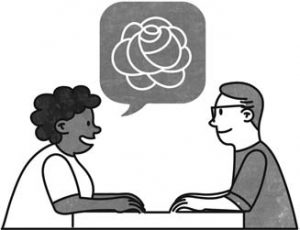Kitchen Table Socialism: Talking Union
What are unions and why do they matter?
Put simply, a union is an organization of workers acting collectively to defend and advance their common interests. Most people in capitalist society must sell their capacity to work to employers in exchange for the wages necessary for survival. Bosses cement their authority by sowing division among workers in desperate competition for jobs.

Hallie Jay Pope
Challenges to this structural inequality are possible only when workers act together and strategically deploy their strength in numbers in and beyond the workplace. Workers may engage in a variety of collective actions, but the strike remains their most potent weapon. Ceasing production or service en masse jeopardizes the capitalist accumulation of profit.
Unions operate within the constraints of a capitalist system and are not inherently socialist institutions. But democratic socialists understand their potential as vehicles for social change.
How have socialists contributed to the development of the labor movement in the United States?
From Haymarket to Lawrence to Flint, socialists have proved crucial actors in the most significant U.S. labor uprisings. Before he became the voice of the Socialist Party of America (SP), Eugene Debs led a quarter of a million railway workers on a strike against the Pullman Company that captivated the nation. A decade afterward, he joined fellow radicals to found the Industrial Workers of the World, which pioneered industrial unionism and solidarity across the color line.
Amid the Great Depression, members of the SP and the burgeoning Communist Party played an indispensable role in the construction of the Congress of Industrial Organizations. These radicals advocated multiracial, multiethnic unionism and built the most progressive organizations in the land. Acquiescing to the Second Red Scare of the late 1940s and 1950s, labor leaders’ disgraceful decision to purge radicals inflicted lasting damage on the vitality of labor unions.
Later, radicals participated in the wave of public-employee organizing during the postwar era, and New Left activists helped generate rank-and-file reform insurgencies beginning in the 1970s. Recently, socialists have bolstered renascent teacher unionism in Chicago, West Virginia, and Massachusetts.
What is the crisis facing unions?
Union density has reached its lowest point since the 1920s—barely one out of ten Americans are members. With private-sector organization decimated, nearly half of all union members are government employees. In addition, over half of all union members reside in just seven states. More alarming than the decline in union density is the decline in strike activity. Several hundred major strikes occurred annually prior to the 1980s, whereas last year featured a total of seven major ones—the second-lowest number in more than half a century (the lowest was 2009).
These patterns are not the result of inevitable changes in the global economy; they are the result of the ruling classes’ deliberate project to strangle workplace democracy.
The ascendancy of what is called an “open shop” has been a keystone of this effort. In a majority of states, private-sector workers are now allowed to refuse to join or fund their union, even though they continue to benefit from the gains made by the union. This is a direct threat to unity and a prime opportunity for employers to divide and conquer. The recent Supreme Court ruling in Janus v. AFSCME mandates the same for the entire public sector.
In this terrifying moment, however, signs of hope surround us. The astonishing teacher strikes, spreading across states where labor law is most prohibitive and unions are weakest, confirm the enduring value of mass struggle. How we as democratic socialists might shape and support a revival of working-class power in the 21st century is one of the central questions confronting DSA.
 Democratic Socialists of America
Democratic Socialists of America